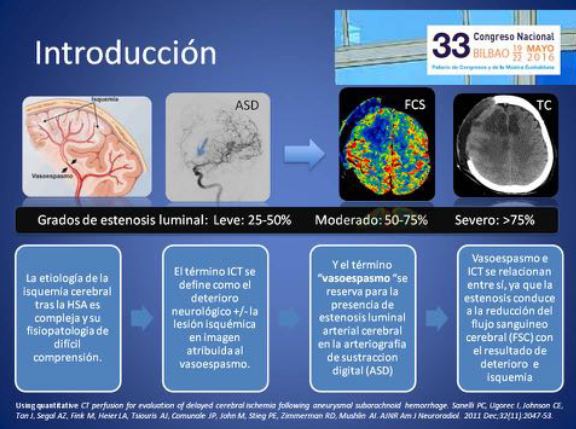TC DE PERFUSION Y ANGIO-TC:
¿SON DE UTILIDAD PARA EL DIAGNÓSTICO DE LA ISQUEMIA CEREBRAL TARDIA TRAS HEMORRAGIA SUBARACNOIDEA?
Palabras clave:
SQUEMIA CEREBRAL TARDIA, HEMORRAGIA SUBARACNOIDEA, poster, seram, TCP, angio-TCResumen
Objetivos Docentes
La enfermedad cerebrovascular es la tercera causa de muerte en países industrializados. De todos los tipos de enfermedad cerebrovascular, la hemorragia subaracnoidea (HSA) es responsable de hasta un 30% de la mortalidad. Alrededor de un 20-30% de los pacientes con HSA secundaria a ruptura aneurismática cerebral van a desarrollar vasoespasmo arterial que puede conducir a la isquemia cerebral tardía (ICT).
Revisión del tema
La relación entre vasoespasmo cerebral y HSA en el TC inicial fue descrito por Takemae (6) .Claasen, et al mediante un modelo de regresión logistica multivariante que incluía datos de TC y variables clínicas encontraron cuatro predictores independientes de la isquemia cerebral tardia: presión arterial media >112mmHg, hemorragia intraventricular en ambos ventrículos laterales, velocidades de flujo medias >140cm/segundo en el Doppler Transcraneal y el espesor de la hemorragia en cualquier cisterna. De todas estas variables, la hemorragia intraventricular fue el predictor más fuerte de isquemia cerebral tardia, multiplicándose x3 el riesgo de ICT en los pacientes con hemorragia intraventricular.
Descargas
Citas
Delayed cerebral ischemia in aneurysmal subrachnoid hemorrhage: proposal of an evidence based combined clinical and imaging reference standard. Sanelli, S. Kishore, A. Gupta, H. Mangat, A. Rosengart, H. Kamel, and A. Segal.AJNR Am J Neuroradiol 35:2209 –14 Dec 2014.
Using quantitative CT perfusion for evaluation of delayed cerebral ischemia following aneurysmal subarachnoid hemorrhage. Sanelli PC, Ugorec I, Johnson CE, Tan J, Segal AZ, Fink M, Heier LA, Tsiouris AJ, Comunale JP, John M, Stieg PE,Zimmerman RD, Mushlin AI. AJNR AmJ Neuroradiol. 2011 Dec;32(11):2047-53.
Vasospasm after Subarachnoid Hemorrhage:Utility of Perfusion CT and CT Angiography on Diagnosis and Management. M. Wintermark,N.U. Ko, W.S. Smith, S. Liu, R.T. Higashida, W.P.
Dillon. Wintermark AJNR 27 Jan 2006 .
CT Angiography and Perfusion CT in Cerebral Vasospasm after Subarachnoid Hemorrhage. S. Binaghi ,M.L. Colleoni, P. Maeder, AUske´, L. Regli, A.R. Dehdashti,P. Schnyder, R.Meuli.
Binaghi AJNR 28 Apr 2007.
Evaluating CT Perfusion Using Outcome Measures of Delayed Cerebral Ischemia in Aneurysmal Subarachnoid Hemorrhage. P.C Sanelli, N.Anumula,C.E Johnson, J.p. comunale, A.jTsiouris, H.Riina, A.Z Segal, P.E Stieg, R.D Zimmerman and A.I Mushlin. AJNR Am J Neuroradiol 34:292-98 Feb 2013.
Computed Tomography Grading Schemes Used to Predict Cerebral Vasospasm After Aneurysmal Subarachonid Hemorrhage: A Historical Review. Paul klimo Jr. M.D, Richard H. SChmidt, M.D, PhD. Neurosurg Focus. 2006;21(3) © 2006 American Association of Neurological Surgeons.


